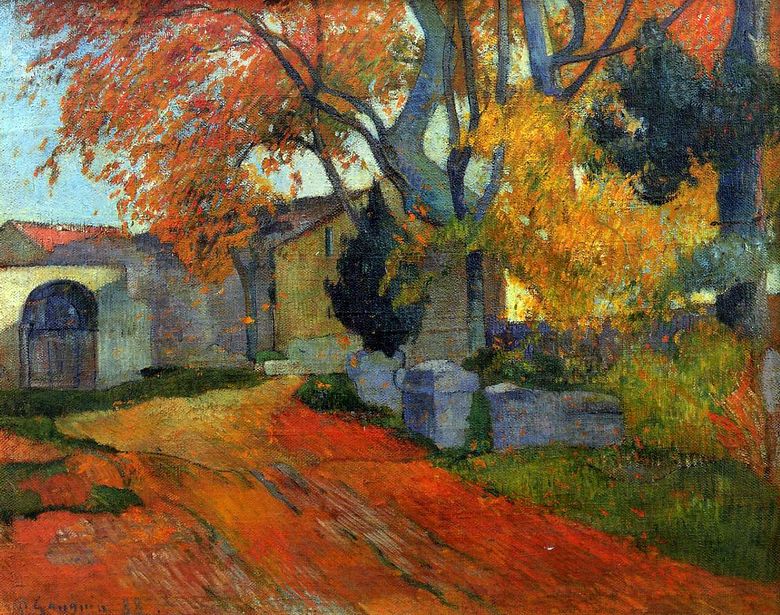
The work of Paul Gauguin “The Road” is a canvas, saturated with colors and juice of pure color. It is written in the traditional direction of post-impressionism, revered by the author, as a means of self-expression and narration of the deep beauty of reality. It’s a landscape. The place to which the painting is dedicated is a cozy and picturesque place in the south of France. A small town in Provence was a frequent guest of the author’s paintings in 1888, when Paul found a temporary refuge with Van Gogh. Red-haired with still green grass, but wilting trees, Arles froze with pure colors on canvas Gauguin.
A small narrow street with a building of the XVIII century is written with an outline of walls, roofs of houses and trunks. An illustration of the quiet life of the town is made by hot and contrasting spots. Paul did not skimp on a juicy clean color. There is an orange crown, and a red-terracotta earth, apparently covered with fallen leaves. A quiet corner with a dry and crispy dryness lay in a beautiful arrangement. The abundance of road space in the foreground is balanced by a mixture of stone walls, dancing leaves and far-off branches. The landscape is written from nature, but unlike classical realism, the work is similar to the scheme of objects and color blots.
This is a new interpretation of nature, and indeed of everyday scenes, peculiar, just the same, to the post-impressionist Gauguin. In an effort to convey the charm of the surrounding reality – a cozy Arles with his secrets – the artist resorted to new, simple and win-win principles of writing and styling the original. Based on the pattern of the impressionist use of color and its contrast, Gauguin made “play” different planes with more juicy colors, elegant, but clean “by sound.” Despite the more or less primitive image, the work does not seem to be an applique.
Dynamics of strokes in the given direction creates the illusion of wind and breathing of nature. Gauguin is characterized by a dry letter without oily smears. The volume he achieves with the play of light and shadow, as here – the transition from a yellow spot of light into a red juicy on the road, from a cold shadow on the wall with a wooden door to a light vanilla color just above, a combination of playing gray and white spots on the trunks. Hohen Arles is a cozy work. A short segment of the flaming road takes the viewer into the dry French autumn, somewhere bright, somewhere damp and sad, as in the song of Yves Montand with “Falling leaves hovering outside the window…”.
 Landscape by Paul Gauguin
Landscape by Paul Gauguin Beautiful days by Paul Gauguin
Beautiful days by Paul Gauguin Harvesting fruits by Paul Gauguin
Harvesting fruits by Paul Gauguin Apple trees by Paul Gauguin
Apple trees by Paul Gauguin Route d’Arly – Paul Gauguin
Route d’Arly – Paul Gauguin Mountains in Tahiti by Paul Gauguin
Mountains in Tahiti by Paul Gauguin Marae by Paul Gauguin
Marae by Paul Gauguin Round dance of small brethren by Paul Gauguin
Round dance of small brethren by Paul Gauguin